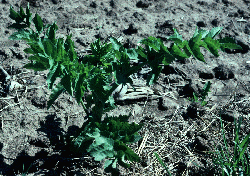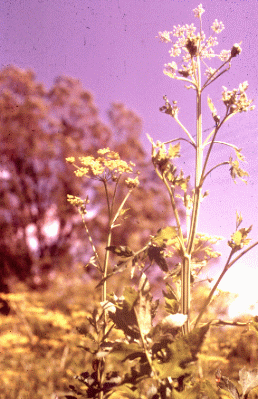Wild parsnip
Other Common Names:
Scientific Name: Pastinaca sativa
 |
 |
![]()
Parsnip
Botanical: Pastinaca sativa
Family: N.O. Umbelliferae
Medicinal Action and Uses
---Synonyms---(French) Le Panais. (German) Die Pastinake.
---Part Used---Root.
---Habitat---The Wild Parsnip is a native of most parts of Europe, growing chiefly in calcareous soils, by the wayside and on the borders of fields.
The food value of Parsnips exceeds that of any other vegetable except potatoes. It is easy of production and should be more extensively grown.
The Parsnip, together with the carrot, was cultivated by the Ancients, but the Roman horticulturists evidently knew nothing of the advantage of selecting seeds, by means of which the best existing variety has been developed. Pliny tells us it was grown either from the root transplanted or else from seed, but that it was impossible to get rid of the pungent flavour. The finest strain raised by Professor Buckrnan, between 1848 and 1850, as a result of his experiments in selection, was named by him the 'Student,' and having been further improved, still takes thefirst rank. It differs in several respects from the wild plant.
According to Pliny, Parsnips were held in such repute by the Emperor Tiberius that he had them annually brought to Rome from the banks of the Rhine, where they were then successfully cultivated. They are dressed in various ways and are much eaten with saltfish during Lent.
In Holland, Parsnips are used in soups, whilst in Ireland cottagers make a beer by boiling the roots with water and hops, and afterwards fermenting the liquor. A kind of marmalade preserve has also been made from them, and even wine which in quality has been said to approach the famed Malmsey of Madeira.
It has a tough, wiry root, tapering somewhat from the crown, from which arises the erect stem, 1 to 2 feet high, tough and furrowed. The leaf-stalks are about 9 inches long, the leaves divided into several pairs of leaflets, each 1 to 2 inches long, the larger, terminal leaflet, 3/4 inch broad. All the leaflets are finely toothed at their margins and softly hairy, especially on the underside. The sheath at the base of the leaf-stalk is about 1 1/2 inch long, the first pair of leaflets being 4 inches above it.
The modern cultivated Parsnip has developed a leaf-stalk 2 feet long, the first pair of leaflets being several inches above the sheath. The leaflets are oblong, about 2 inches across at the basal part and 4 1/2 inches in length (more than double the size of those of the wild plant), and are entirely smooth and somewhat paler in colour. The flowers in each case are yellow and in umbels at the ends of the stems, like the carrot, though the umbels do not contract in seeding, like those of the carrot. The flowers of the cultivated Parsnip are of a deeper yellow colour than those of the wild plant. The Parsnip is a biennial, flowering in its second year, throughout June and August. The fruit is flattened and of elliptical form, strongly furrowed. Parsnip 'seeds' as the fruit is commonly called, are pleasantly aromatic, and were formerly collected for their melicinal value and sold by herbalists. They contain an essential oil that has the reputation of curing intermittent fever. A strong decoction of the root is a good diuretic and assists in removing obstructions of the viscera. It has been employed as a remedy for jaundice and gravel.
---Medicinal Action and Uses---Culpepper wrote: 'The wild Parsnip differeth little from the garden, but groweth not so fair and large, nor hath so many leaves, and the root is shorter, more woody and not so fit to be eaten and, therefore, more medicinal. The Garden Parsnip nourisheth much and is good and wholesome, but a little windy, but it fatteneth the body if much used. It is good for the stomach and reins and provoketh urine. The wild Parsnip hath a cutting, attenuating, cleansing and opening quality therein. It easeth the pains and stitches in the sides and expels the wind from the stomach and bowels, or colic. The root is often used, but the seed much more, the wild being better than the tame.'
Gerard, speaking of its uses as a vegetable, observes: 'The Parsneps nourish more than do the Turneps or the Carrots, and the nourishment is somewhat thicker, but not faultie nor bad.... There is a good and pleasant foode or bread made of the rootes of Parsneps, as my friend Master Plat hath set foorth in his booke of experiments.'
Tournefort, in The Compleat Herbal (1730), wrote of Parsnips, that: 'they are commonly boiled and eaten with butter in the time of Lent; for that they are the sweetest, by reason the juice has been concocted during the winter, and are desired at that season especially, both for their agreeable Taste and their Wholesomeness. For they are not so good in any respect, till they have been first nipt with Cold. It is likewise pretty common of late to eat them with salt-fish mixed with hard-boiled eggs and butter . . . and much the wholesomer if you eat it with mustard.'
John Wesley, in his Primitive Physic, says: Wild parsnips both leaves and stalks, bruised, seem to have been a favorite application; and a very popular internal remedy for cancer, asthma, consumption and similar diseases.'
The roots are sweeter than carrots. They contain both sugar and starch, and for this reason beer and spirits are sometimes prepared from them. In the north of Ireland, they have been often brewed with malt instead of hops and fermented with yeast, the result being a pleasant drink, and Parsnip wine, when properly made, is esteemed by many people.
Parsnips are not only a valuable item of human food, but equal, if not superior to carrots for fattening pigs, making the flesh white, and being preferred by pigs to carrots. Washed and sliced and given with bran, horses eat them readily and thrive on them. In Brittany and the Channel Islands, they are largely given to cattle and pigs, and milch cows fed on them in winter are said to give as much and as good milk, and yield butter as well-flavoured as when feeding on grass in May and June.
---Cultivation---Parsnips require a long period of growth, and should be started, if possible, the latter part of February. In choosing the seed, the older varieties should be avoided, as there is no comparison between them and the newer and better kinds. The 'Student,' already mentioned, is suited in every way for the average small garden.
No specially good soil is required, though a strong soil is preferable to a sandy one; poorish or partially exhausted soil is no drawback, as there should be no recent manure in the top spit, for in common with carrots, its presence tends to form forked roots. The ground, however, should be deeply trenched and a slight dressing of manure may be buried deeply. Roots will be poor if grown in soil which has hardly been turned over, but if the land is deeply dug, plenty of lime, old mortar rubbish or wood ashes being mixed in, fine roots will be produced.
One ounce of Parsnip seed will sow a row 300 feet long. The seed is best sown in drills about 1 inch deep, as soon as the land is anything like dry enough to work. Drop three seeds together, 8 inches apart, and let the rows stand 15 inches asunder. After the plants appear, there is very little to do except to thin them and hoe, at intervals; no stimulants are needed. Thinning may be done as soon as they are well in their second leaf.
As the Parsnip is hardy, there is no need to lift the roots in autumn. The crop will be ready for use in September, but it may be left in the ground and be dug throughout the winter as required, and the remainder not finally raised till the middle or end of February, when the site the roots occupy has to be prepared for the crop of the ensuing summer.
A large green caterpillar with black stripes and yellow spots frequently appears in gardens on dill, parsley and carrot. Have you ever wondered what this caterpillar becomes? Your yard has been blessed with a visit by a wandering Black Swallowtail (Papilio polyxenes), a four-inch black beauty with a yellow band along its wings. Make room for a few extra plants and let the caterpillar feed and live. In the wild, black swallowtails feed on wild carrot, wild parsnip and golden alexander.
![]()
 Wildflower
Seed For Sale
Wildflower
Seed For Sale